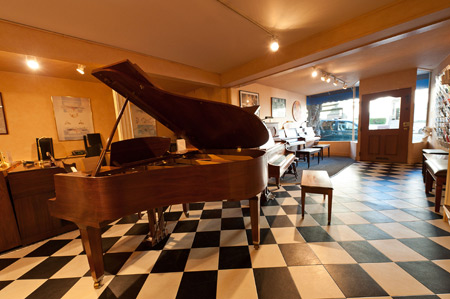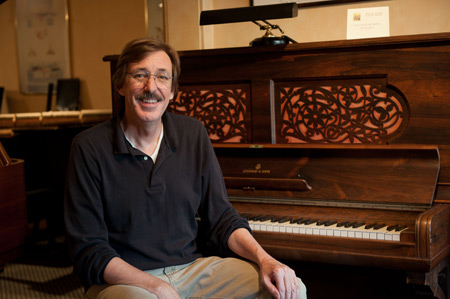By Marjorie Leet Ford
THE SHOP’S carved wooden front door — both rough-hewn and fancy — quietly announces a portal to another time, when the ancient art of piano building was still going strong, and the world was as full of pianos as it now is of cars. The piano was the heart of the family; there were so many that some cities passed laws against playing a piano near an open window. Then came the radio and the gramophone, providing instant music.
But the romance lingers. Having the word “piano” in a title still wins hearts. Witness Thad Carhart’s high-selling novel The Piano Shop on the Left Bank; Jane Campion’s popular film The Piano and The Pianist, which became an Oscar winner for its director, Roman Polanski.
Romance may be part of the pleasure in opening the front door and stepping into the Piano Care Co. at 2011 Divisadero Street, just a few steps north of California.
Once inside, your eye rivets to a Victorian upright with curlicue latticework decorating the front panel. It’s such a rare design that if it didn’t have a keyboard, you might not know it was a piano. It was built in 1882, when uprights were making inroads on grands. This was one of Steinway & Co.’s first attempts at something newer, smaller, trimmer: a piano with the soundboard, the cast iron harp and the strings standing up straight, hidden in the back, instead of spreading out flat in the traditional grand piano style. Next to this 1882 work of art you might find a great grand that’s 100 years younger, or a spinet from the 1950s.
Customers come in the shop to try their hands on a keyboard, to browse for a book of music or a special piano lamp, to ask advice about their own pianos, or just to chat with the two men who work there.
The proprietor, John Schaecher, a registered piano technician certified by the national Piano Technicians Guild, has tuned pianos for the San Francisco Symphony, Skywalker Ranch and the Plush Room, as well as for countless neighborhood pianists. On any given day, he may be out tuning or in the front of the shop greeting visitors.
Piano Care staffer Robert Bell will be either in the backroom shop, restoring beloved pianos, or out front with the fine pianos the shop has restored to perform like new.
Schaecher opened his original Piano Care Co. on Divisadero near Oak in 1980, living upstairs above the shop. A few years later he moved up Divisadero past California Street — a much better place for a piano shop, complete with a home above, where he has lived for the last 20 years.
He met Robert Bell through another conflict. The two were rivals at an auction held by the Piano Technicians Guild, both battling for a demonstration model. Bell’s hand went up first, but Schaecher’s went higher — and the fight went on until Bell had to admit defeat.
Schaecher said to Bell: “You were the only one there who knew the value of that instrument. Would you like to come to work for me?” And so he got an expert who has become a mainstay of his piano shop.
Bell seems to know just about everything about the piano except how to play. “I play poorly,” he claims, but it’s an overly modest statement. An aspiring rock star, he went to music school to specialize in guitar and percussion, but he played piano well enough to surmount the school’s “piano barrier” and graduate.
Bell seems enamored of the piano’s workings. “The player never touches the instrument,” he says. “You touch the keys, but they aren’t the instrument. The instrument is inside.”
The piano is said to be the most complex machine ever invented, with 12,000 moving parts, purportedly the same number of parts as the space shuttle.
The complexity is intriguing — and particularly satisfying — to a certain kind of person. In one study of job satisfaction, from cardiologist to night watchman, piano technician rates highest in terms of happiness. Some muse that it’s not just because these technicians love pianos; it’s the people.
“One thing is sure,” according to one local piano technician. “Anyone who owns a piano is an interesting person.”
One day a while back, a most interesting person stepped through the front door of the Piano Care shop: a soloist with the San Francisco Ballet, Pascale Leroy, who was about to retire from dancing and teach at the San Francisco Ballet School.
“I can’t keep dancing on stage,” she said. “But what I love most about dancing is the music. So I want to buy a piano and learn to play.”
Bell suggested she rent one, to see if she liked it; if she did, her payments could go toward purchasing it.
She liked the piano.
And she liked him.
Now they’re married and live with the piano she bought — and with their 10-year-old daughter, Lilia, who’s taking ballet at the San Francisco Ballet School, this year with her mother as her teacher.
“It’s funny,” says Bell. “When Pascale talks about ballet, she doesn’t talk about dancing on the floor. She dances ‘on the music.’ ”
[nggallery id=27]







